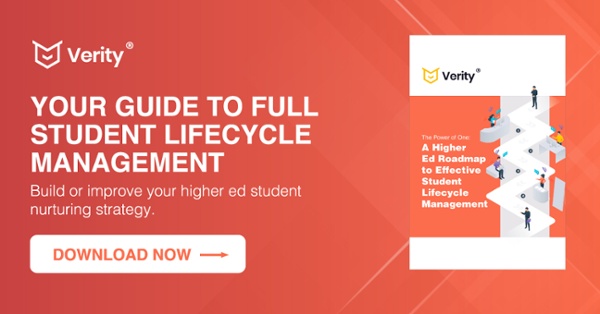3 Mistakes to Avoid When Talking to Prospective Students
Talking to prospective students is one of the most exciting parts of working in Higher Ed. Their energy, excitement, and hopefulness are contagious and it’s fun to think about what the next freshman class will bring to campus.
You could be talking to prospective students anywhere: open house events, on the phone, at college fairs, via social media, or even in line at the grocery store.
In those conversations, you’re typically asking questions like “What are you looking to major in?” and “How did you hear about our school?” You’re probably even sharing a few things about your school and what makes it so unique.
It can be easy to make a misstep in these moments and lower the chance that the prospect will actually apply to your school. The good news is that they’re super avoidable!
Here are 3 mistakes to watch out for when talking to prospective students.
1. Talking Too Much About Your School’s Offerings
Your school is a wonderful place for young people to get an amazing education, make new friends, learn about themselves, and start the next chapter of their lives.
Here’s the trick, though: try to resist talking about that too much upfront.
It’s a common mistake in enrollment marketing and a trap that many Higher Ed professionals fall into. After all, it’s their job to make the school stand out from its competition in order to hit its enrollment targets. How can you do that without bragging about your school?
It’s been well-documented that consumers today don’t like being sold to and will tune you out if you’re pushing too hard, too early. The same is true for prospects in their college application process.
There’s certainly a time and place for talking about what makes your school so special. However, make sure that when you’re talking to prospective students, you’re putting them in the center of the story.
What’s the prospect looking for in a school? What types of programs are they considering? What’s important to them? These are all important factors when choosing a college, so learn as much as possible about their considerations as they narrow down their college choices.
The better you understand that student’s unique needs and priorities, the better you can give them the information they need to determine whether or not your school is the right place for them.

2. Not Offering an Intentional CTA for Next Steps
Does each point along your student journey have a clear, intentional call-to-action (CTA)?
As soon as every conversation ends, your prospect should know exactly where they should be going next.
Far too often, schools offer the same CTA again and again: “Apply Now!”
Yes, a student should always have a clear path to starting their application if they're ready. However, schools should really think about what assets and resources pair well together so the prospect can continue learning on their own terms.
If they’ve expressed interest in pursuing a career in Criminal Justice, for example, maybe send them a guide that outlines their career options after graduating, salary expectations, and how your program will help prepare them for success.
If you know they’re seriously considering your school and are finalizing their decision, invite them to the open house event you’ve got coming up.
The next step should always be incremental, intentional, and clear. If they have to guess what they’re supposed to do next, they might not return and you could lose that prospect to a school that has more intentional action items and a clear, established student journey.
3. Asking for Too Much Information Up Front
Building on our earlier point, the more you know about a prospective student, the easier it is to position your school as a top choice.
So, when talking to prospects, it may be enticing to ask for as much information as possible on a form: their home address, phone number, program of interest, GPA, email address, birth date, level of education, etc…
However, this will likely only prevent students from filling out the form at all. The fewer form fields, the better. In fact, by reducing the number of form fields to 4 or fewer you can increase conversions by up to 160%!
So, how do you then collect as much information as possible about your prospects?
It all comes back to building a well-defined student lifecycle management strategy. Your goal should be to get just enough information at each step to guide the prospect through the student lifecycle.
What does your student lifecycle management strategy look like? We put together a sample roadmap to help you create (or improve) a strategy that creates unforgettable student experiences. Download The Power of One: A Higher Ed Roadmap to Effective Student Lifecycle Management
Here’s a quick example of how that might play out. Say you meet a prospective student at a college fair and they show a genuine interest in your school. At your table, you should have a sign-up sheet with their name and email address so that you can follow up with more information about what the school has to offer.
The prospect should then be enrolled in an email nurturing workflow in which you send additional resources and links to your program pages. The prospect could then visit your website, read more about the programs, and submit a form to speak with an admissions representative in which they provide their name, home address, and program of interest.

Now that you have those, you could mail brochures and flyers to their home with more information about that program and invite them to your next open house event. At the open house, you can get their phone number so that you can follow up and ask how they liked the event and see what additional questions you could answer.
Of course, this scenario is oversimplified (don’t you wish recruiting was that easy?). However, the core principles are the same: collecting information in a natural, incremental way without being pushy.
When you execute it well, you’ll build robust student records on your prospects while delivering incredible value to them every step of the way.


